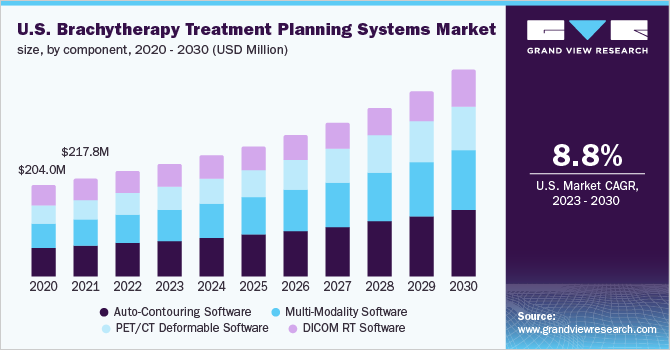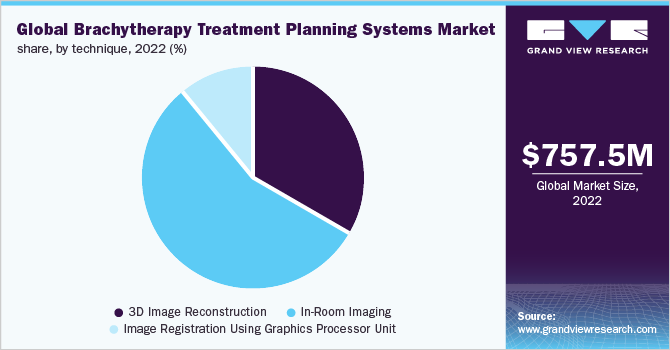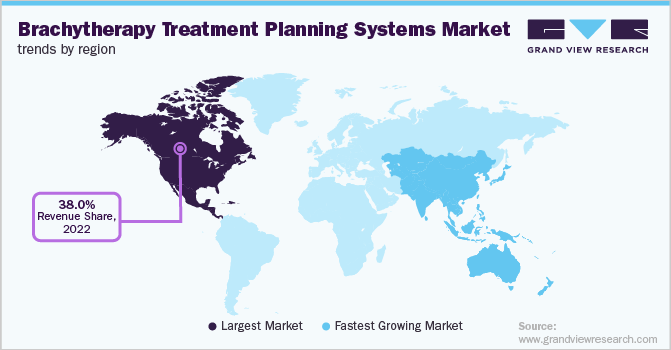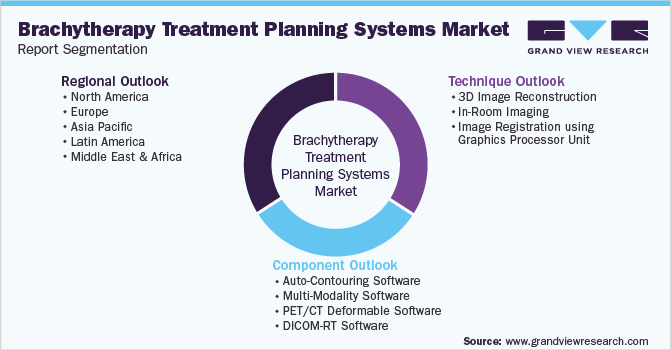- Home
- »
- Healthcare IT
- »
-
Brachytherapy Treatment Planning Systems Market Report, 2030GVR Report cover
![Brachytherapy Treatment Planning Systems Market Size, Share & Trends Report]()
Brachytherapy Treatment Planning Systems Market Size, Share & Trends Analysis Report By Component (PET/CT Deformable, Auto-Contouring Software), By Technique (3D Image Reconstruction, In-Room Imaging), And Segment Forecasts, 2023 - 2030
- Report ID: GVR-4-68039-915-6
- Number of Report Pages: 114
- Format: PDF, Horizon Databook
- Historical Range: 2017 - 2021
- Forecast Period: 2023 - 2030
- Industry: Healthcare
Report Overview
The global brachytherapy treatment planning systems market size was valued at USD 757.5 million in 2022 and is projected to grow at a compound annual growth rate (CAGR) of 9.5% from 2023 to 2030. The rapidly growing prevalence of cancer and cancer-related mortality across the globe is accelerating the demand for innovative cancer care therapies. The growing demand for accurate & precise diagnoses to prevent cancer-related mortality through adequate & timely treatment plans is boosting the demand for brachytherapy treatment planning systems. Radiation therapy is gaining acceptance in cancer care solutions as one of the most cost-effective treatments owing to its accuracy and efficiency. According to an article published by the International Journal of Medical Sciences, approximately 50% of cancer patients are opting for radiation therapy.

According to the Globocan 2020 estimates, in 2020, there were approximately 19.3 million cancer cases detected across the globe and some of the most common cancers detected were prostate cancer (7.3%), breast cancer (11.7%), colorectal cancer (10.0%), and lung cancer (11.4%). Further estimates predict a sharp increase of 47% in the caseload in 2040 as compared to 2020. According to the Globocan estimates, there would be 28.4 million new cancer cases diagnosed in 2040 across the globe. Market players are focusing on innovative product development strategies to diversify their product portfolio and serve unmet medical need areas through their innovative oncology care segment, which is anticipated to support growth over the coming years.
Advancements in the healthcare IT sector and growing healthcare infrastructure, increasing integration of AI/ML algorithms in cancer care therapies, rising public-private partnerships & growing investments in cancer care segments, and rising demand for advanced care solutions are also propelling the market growth. The radiation therapy sector is undergoing constant innovations and advancements with the emergence of novel technologies capable of significantly transforming the market. Through the support of advancing healthcare infrastructure and growing healthcare spending, the market is anticipated to witness lucrative growth over the forthcoming years.
Key participants are focusing on growth opportunities in emerging economies with the development of healthcare infrastructure and growing digital healthcare literacy. Furthermore, favorable government initiatives and the promotion of public-private partnerships in cancer care and radiation therapy will boost product innovation and development. For instance, the Australian government launched Victorian Cancer Plan 2020-2024 to improve cancer care strategies and cancer outcomes through early detection and timely treatment. In 2019, Barwon Health Foundation collaborated with Varian Medical Systems to inaugurate Andrew Love Cancer Center Chemotherapy Day Ward and Oncology Pharmacy to improve the accessibility of brachytherapy treatment planning solutions.
Moreover, the adoption of AI/ML algorithms in cancer detection and screening will also support market growth. These advanced algorithms help healthcare professionals in brachytherapy treatment planning processes and improve the outcomes with minimal collateral tissue damage. The growing demand for AI/ML algorithms is driving market players to integrate these solutions into their existing offerings. To boost the integration of AI/ML algorithms in oncology care solutions, the American College of Radiology inaugurated the Data Science Institute promoting collaboration among public & private agencies, oncologists, radiologists, and other healthcare professionals.
Furthermore, continuous development in medical technology processes helps improve accuracy & precision and enhance the patient treatment experience. There have been recent developments in radiotherapy technologies, and it is widely adopted and applied in treatment planning, treatment simulation, and image guidance. In addition, an increase in strategic investments and initiatives in cancer care by companies is driving the market growth. For instance, in 2019, Elekta announced the acquisition of ProKnow for boosting the digital radiotherapy strategies of the company. In September 2020, the company announced the launch of a new linear accelerator called Elekta Harmony in the market.
COVID19 brachytherapy treatment planning systems market impact: an increased growth of 7.0% between 2019 and 2020
Pandemic Impact
Post COVID Outlook
The brachytherapy treatment planning systems market grew at a rate of 7.0% from 2019 to 2020.
The market is estimated to witness a year-on-year growth of ranged from 8.0% to 8.5% in the next 5 years
The global impact of the COVID-19 pandemic was unexpected and unprecedented impacting every company’s fiscal year performance due to a significant decline in demand and supply chain disruptions. Furthermore, customer delays & defaults rose drastically, and payment delays made the financial performance of players even more challenging
The capital-intensive nature of the radiation therapy space restrained adoption and growth. moreover, deferrals of non-urgent elective procedures affected the revenue generation of companies and private healthcare facilities. However, the market was not impacted drastically owing to the growing adoption of brachytherapy treatment planning systems and advancements in AI/ML integration
The vulnerable communities of the society, such as elderly cancer patients, immunosuppressed cancer patients, and patients with comorbidities, needed radiation therapy, which would require healthcare facilities to devise strategies to minimize contact between patients, and radiologists & oncologists
Oncology radiation planning strategies were being implemented to minimize transmission and hospitals began segregating task forces with personnel as per priority and availability of resources
The product would help in curbing the increasing cancer burden at a global level. Key participants are focusing on their mergers & acquisitions and collaboration strategies to gain a competitive edge in the market and expand their business across various geographies. For instance, in February 2020, MIM Software collaborated with Isoray, Inc. to develop an innovative one-stop solution for head and neck cancer care services. Under this collaboration, the new innovative solution would combine MIM’s software technology and Isoray’s Cesium 131 (also known as Cesium Blu), expanding brachytherapy treatment solutions.
Component Insights
The auto-contouring software segment dominated the market in 2022 and accounted for the largest revenue share of 31.4% owing to the growing popularity and adoption of auto-contouring software solutions over manual contouring software. Manual contouring techniques lack standardization, efficiency, and accuracy, restrain their adoption, and support the growth in demand for partial or fully automatics contouring solutions for radiation therapy. Automatic contouring using Hounsfield values is used in reducing turnaround time and enhancing accuracy. According to case studies published by MIM Software, 10 minutes are saved per patient on prostate target volume contouring in radiation oncology.
The rapidly increasing geriatric population coupled with the increasing prevalence of cancer & mortality boosts the need for radiotherapy optimization. Among radiotherapy treatment planning processes, one of the most important tasks is automating the contouring solutions since manual techniques could be flawed and tedious. The constant product innovations, approvals, and certifications from governing bodies will drive the segment. For instance, in July 2020, MIM Software Inc.’s Contour ProtégéAI received the U.S. FDA clearance. On the other hand, PET/CT deformable software segment is anticipated to register the fastest CAGR over the forecast years.
PET imaging provides information on the intensity and extent of the tumor while CT imaging outlines the anatomical structure of the tumor and surrounding healthy tissues. Deformable image registration combines the images from two or more modalities into a common coordinate system. For better correlation of the tumor, PET and CT images can be co-registered. Deformable image registration is used for organ delineation, targeting volume definition, and dose calculation. The driving forces of this segment include an increase in the number of acquired image datasets, advancements in multi-modal images in treatment planning, and the adoption of image-guided radiotherapy practices.
Technique Insights
The in-room imaging segment dominated the global market in 2022 and accounted for the largest revenue share of 55.2% owing to constant technological innovations in the radiation therapy space. In-room imaging techniques are gaining popularity due to the enhanced accuracy & precision and growing emphasis on normal tissue radiotherapy toxicity reduction and dosage volume reduction. Therefore, in-room imaging aids in reducing therapy uncertainties. The in-room imaging process provides radiologists with real-time image datasets and allows them to overcome challenges arising from movable tumors and target lesions.

Various benefits associated with in-room imaging, such as reduced dosage toxicity, improved target localization, improved tumor control, and quicker therapy duration, are driving its adoption. On the other hand, the 3D image reconstruction segment is anticipated to register the fastest CAGR over the forecast years. 3D image reconstructions function through image segmentation, image registration, and image visualization. 3D image reconstruction processes are used to create 3D image projections through multiple techniques, such as photometric stereo handling, multiple Kinect capturing system, triangulation method, and visualization.
Various benefits offered by 3D image reconstruction techniques are dosage distribution planning, minimal collateral tissue damage, and optimal treatment process realization. The increasing demand for accurate & precise oncology treatment practices to improve patient outcomes and tackle the rapid prevalence of cancer incidence across the globe is driving the 3D image reconstruction segment. Healthcare infrastructure is rapidly advancing and incorporating innovative technologies, which is another driving factor for this segment. Developments in spatial registration and fusion of 3D images procured from different modalities are shaping the segment growth.
Regional Insights
North America dominated the global market in 2022 and accounted for the largest revenue share of more than 38% owing to the rapidly advancing healthcare infrastructure and growing healthcare spending. Increasing cancer prevalence coupled with a growing aging population is driving the growth. For instance, as per the National Cancer Institute, in January 2019, the U.S. had a cancer caseload of 16.9 million and is estimated to reach 22.2 million by 2030. The abovementioned factors are driving the demand for innovative technological solutions in cancer care in North America. The presence of adequate healthcare & cancer care facilities and the rise in the number of cancer research institutes are driving the regional market growth.

The presence of a favorable reimbursement framework is another factor responsible for market growth. The rising number of product innovations in the cancer care segment is helping in reducing cancer-related mortality in North America. On the other hand, Asia Pacific is anticipated to register the fastest growth rate over the forecast period owing to the developments in emerging economies, such as China and India. The presence of large untapped opportunities and prominent unmet medical needs in developing nations in Asia Pacific region is supporting the regional market. The advancing healthcare industry and growing digital literacy in several countries is boosting the market growth.
Rising cancer prevalence and cancer-related mortality in this region are majorly responsible for the lucrative growth rate. Growing healthcare spending by both public and private stakeholders is supporting market growth. Furthermore, organizations and agencies are undertaking multiple initiatives to spread awareness regarding cancer screening and accelerate penetration.
Key Companies & Market Share Insight
These key players are devising innovative product development strategies to expand their product portfolio and gain a competitive edge. Companies are collaborating with each other to leverage their technological capabilities. In addition, companies are strategically investing in various mergers & acquisitions to expand their product portfolios. For instance, in August 2020, Elekta entered into an agreement with Healthcare Global Enterprises Ltd. (HCG) for the installation of various linac systems, such as Versa HD, Elekta Unity, and Elekta Synergy in India. This service agreement will help the company in gaining a foothold in the Indian market. Some of the key participants in the global brachytherapy treatment planning systems market include:
-
Elekta AB
-
Varian Medical Systems
-
MIM Software
-
RaySearch Laboratories
-
Prowess Inc.
Brachytherapy Treatment Planning Systems Market Report Scope
Report Attribute
Details
Market size value in 2023
USD 817.2 million
Revenue forecast in 2030
USD 1,544.6 million
Growth rate
CAGR of 9.5% from 2023 to 2030
Base year for estimation
2022
Historical data
2017 - 2021
Forecast period
2023 - 2030
Quantitative units
Revenue in USD million/billion and CAGR from 2023 to 2030
Report coverage
Revenue forecast, competitive landscape, growth factors, and trends
Segments covered
Component, technique, region
Regional scope
North America; Europe; Asia Pacific; Latin America; Middle East & Africa
Country scope
U.S.; Canada; U.K.; Germany; Spain; France; Italy; Russia; China; Japan; India; Australia; South Korea; Brazil; Mexico; Argentina; Saudi Arabia; UAE; South Africa
Key companies profiled
Elekta AB; Varian Medical Systems; MIM Software; RaySearch Laboratories; Prowess Inc.
Customization scope
Free report customization (equivalent up to 8 analysts working days) with purchase. Addition or alteration to country, regional, and segment scope
Pricing and purchase options
Avail customized purchase options to meet your exact research needs. Explore purchase options
Global Brachytherapy Treatment Planning Systems Market Report Segmentation
This report forecasts revenue growth at global, regional, and country levels and provides an analysis of the latest industry trends in each of the subsegments from 2017 to 2030. For the purpose of this study, Grand View Research, Inc. has segmented the global brachytherapy treatment planning systems market report on the basis of component, technique, and region:

-
Component Outlook (Revenue, USD Million, 2017 - 2030)
-
Auto-Contouring Software
-
Multi-Modality Software
-
PET/CT Deformable Software
-
DICOM-RT Software
-
-
Technique Outlook (Revenue, USD Million, 2017 - 2030)
-
3D Image Reconstruction
-
In-Room Imaging
-
Image Registration using Graphics Processor Unit
-
-
Regional Outlook (Revenue, USD Million, 2017 - 2030)
-
North America
-
U.S.
-
Canada
-
-
Europe
-
UK
-
Germany
-
France
-
Italy
-
Spain
-
Russia
-
Denmark
-
Sweden
-
Norway
-
-
Asia Pacific
-
Japan
-
China
-
India
-
Australia
-
Thailand
-
South Korea
-
-
Latin America
-
Brazil
-
Mexico
-
Argentina
-
-
Middle East and Africa
-
South Africa
-
Saudi Arabia
-
UAE
-
Kuwait
-
-
Frequently Asked Questions About This Report
b. The global brachytherapy treatment planning systems market size was estimated at USD 703.5 million in 2021 and is expected to reach USD 757.5 million in 2022.
b. The global brachytherapy treatment planning systems market is expected to grow at a compound annual growth rate of 9.3% from 2022 to 2030 to reach USD 1.5 billion by 2030.
b. The in-room imaging segment dominated the brachytherapy treatment planning systems market with a share of 55.4% in 2021.
b. Some key players operating in the brachytherapy treatment planning systems market include Elekta AB; MIM Software, Inc; Prowess, Inc; Varian Medical Systems, Inc; and RaySearch Laboratories
b. Key factors that are driving the brachytherapy treatment planning systems market growth include rapidly growing global cancer prevalence and advancing healthcare IT sector.
Share this report with your colleague or friend.
![gvr icn]()
NEED A CUSTOM REPORT?
We can customize every report - free of charge - including purchasing stand-alone sections or country-level reports, as well as offer affordable discounts for start-ups & universities. Contact us now
![Certified Icon]()
We are GDPR and CCPA compliant! Your transaction & personal information is safe and secure. For more details, please read our privacy policy.
We are committed towards customer satisfaction, and quality service.
"The quality of research they have done for us has been excellent."





